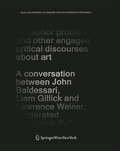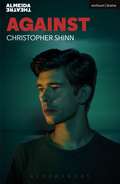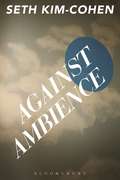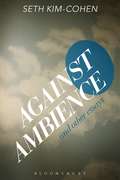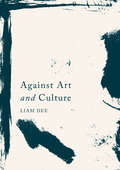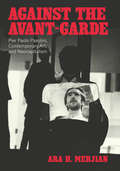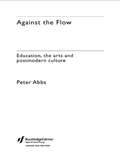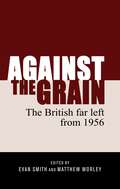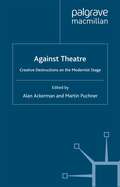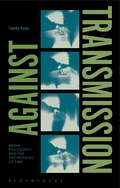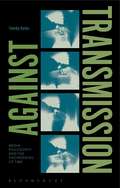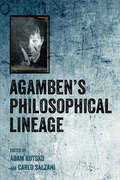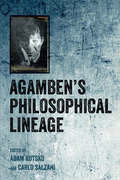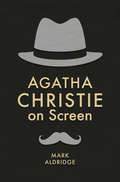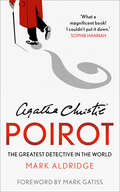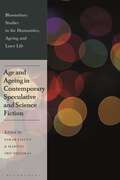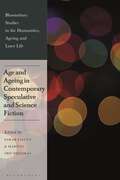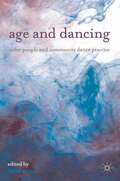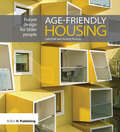- Table View
- List View
Again the Metaphor Problem and Other Engaged Critical Discourses about Art: A Conversation between John Baldessari, Liam Gillick and Lawrence Weiner, moderated by Beatrix Ruf (Kunst und Architektur im Gespräch Art and Architecture in Discussion)
by John Baldessari Liam Gillick Lawrence Weiner Beatrix RufSeit Beginn ihrer Karrieren in den 1960er Jahren sind die amerikanischen Künstler John Baldessari und Lawrence Weiner befreundet. In New York treffen sie den britischen Künstler Liam Gillick zu dem von Beatrix Ruf, Direktorin der Kunsthalle Zürich, moderierten Gespräch. Die Metapher, seit jeher als künstlerisches Verfahren in Verwendung, ist ein wichtiges Problem im Werk dieser drei Künstler, die mit Sprache, Filmbildern und Installationen arbeiten. Im Gespräch eröffnen sich neue Erkenntnisse über die Metapher, über die Funktion der Kunst, über Architektur und über die Rollen und Interessen der Künstler und der Vermittler von Kunst. Ein Gespräch über die Kunstwelt und die Kunst in der Welt.
Against (Modern Plays)
by Christopher ShinnGo where there's violence. Silicon Valley. The future. A rocket launches. Luke is an aerospace billionaire who can talk to anyone. But God is talking to him. He sets out to change the world. Only violence stands in his way.Christopher Shinn's gripping play received its world premiere at the Almeida Theatre on 12 August 2017 in a production directed by Ian Rickson and featuring Ben Whishaw as Luke.
Against (Modern Plays)
by Christopher ShinnGo where there's violence. Silicon Valley. The future. A rocket launches. Luke is an aerospace billionaire who can talk to anyone. But God is talking to him. He sets out to change the world. Only violence stands in his way.Christopher Shinn's gripping play received its world premiere at the Almeida Theatre on 12 August 2017 in a production directed by Ian Rickson and featuring Ben Whishaw as Luke.
Against Ambience
by Seth Kim-CohenAgainst Ambience diagnoses - in order to cure - the art world's recent turn toward ambience. Over the course of three short months - June to September, 2013 - the four most prestigious museums in New York indulged the ambience of sound and light: James Turrell at the Guggenheim, Soundings at MoMA, Robert Irwin at the Whitney, and Janet Cardiff at the Met. In addition, two notable shows at smaller galleries indicate that this is not simply a major-donor movement. Collectively, these shows constitute a proposal about what we want from art in 2013. It's impossible to play possum. While we're in the soft embrace of light, the NSA and Facebook are still collecting our data, the money in our bank accounts is still being used to fund who-knows-what without our knowledge or consent, the government we elected is still imprisoning and targeting people with whom we have no beef. We deserve an art that is the equal of our information age. Not one that parrots the age's self-assertions or modes of dissemination, but an art that is hyper-aware, vigilant, active, engaged, and informed. We are now one hundred years clear of Duchamp's first readymades. So why should we find ourselves so thoroughly in thrall to ambience? Against Ambience argues for an art that acknowledges its own methods and intentions; its own position in the structures of cultural power and persuasion. Rather than the warm glow of light or the soothing wash of sound, Against Ambience proposes an art that cracks the surface of our prevailing patterns of encounter, initiating productive disruptions and deconstructions.
Against Ambience and Other Essays
by Seth Kim-CohenAgainst Ambience diagnoses - in order to cure - the art world's recent turn toward ambience. Over the course of three short months - June to September, 2013 - the four most prestigious museums in New York indulged the ambience of sound and light: James Turrell at the Guggenheim, Soundings at MoMA, Robert Irwin at the Whitney, and Janet Cardiff at the Met. In addition, two notable shows at smaller galleries indicate that this is not simply a major-donor movement. Collectively, these shows constitute a proposal about what we wanted from art in 2013. While we're in the soft embrace of light, the NSA and Facebook are still collecting our data, the money in our bank accounts is still being used to fund who-knows-what without our knowledge or consent, the government we elected is still imprisoning and targeting people with whom we have no beef. We deserve an art that is the equal of our information age. Not one that parrots the age's self-assertions or modes of dissemination, but an art that is hyper-aware, vigilant, active, engaged, and informed. We are now one hundred years clear of Duchamp's first readymades. So why should we find ourselves so thoroughly in thrall to ambience? Against Ambience argues for an art that acknowledges its own methods and intentions; its own position in the structures of cultural power and persuasion. Rather than the warm glow of light or the soothing wash of sound, Against Ambience proposes an art that cracks the surface of our prevailing patterns of encounter, initiating productive disruptions and deconstructions.
Against Ambience and Other Essays
by Seth Kim-CohenAgainst Ambience diagnoses - in order to cure - the art world's recent turn toward ambience. Over the course of three short months - June to September, 2013 - the four most prestigious museums in New York indulged the ambience of sound and light: James Turrell at the Guggenheim, Soundings at MoMA, Robert Irwin at the Whitney, and Janet Cardiff at the Met. In addition, two notable shows at smaller galleries indicate that this is not simply a major-donor movement. Collectively, these shows constitute a proposal about what we wanted from art in 2013. While we're in the soft embrace of light, the NSA and Facebook are still collecting our data, the money in our bank accounts is still being used to fund who-knows-what without our knowledge or consent, the government we elected is still imprisoning and targeting people with whom we have no beef. We deserve an art that is the equal of our information age. Not one that parrots the age's self-assertions or modes of dissemination, but an art that is hyper-aware, vigilant, active, engaged, and informed. We are now one hundred years clear of Duchamp's first readymades. So why should we find ourselves so thoroughly in thrall to ambience? Against Ambience argues for an art that acknowledges its own methods and intentions; its own position in the structures of cultural power and persuasion. Rather than the warm glow of light or the soothing wash of sound, Against Ambience proposes an art that cracks the surface of our prevailing patterns of encounter, initiating productive disruptions and deconstructions.
Against Art and Culture
by Liam DeeOffering a negative definition of art in relation to the concept of culture, this book establishes the concept of ‘art/culture’ to describe the unity of these two fields around named-labour, idealised creative subjectivity and surplus signification. Contending a conceptual and social reality of a combined ‘art/culture’ , this book demonstrates that the failure to appreciate the dynamic totality of art and culture by its purported negators is due to almost all existing critiques of art and culture being defences of a ‘true’ art or culture against ‘inauthentic’ manifestations, and art thus ultimately restricting creativity to the service of the bourgeois commodity regime. While the evidence that art/culture enables commodification has long been available, the deduction that art/culture itself is fundamentally of the world of commodification has failed to gain traction. By applying a nuanced analysis of both commodification and the larger systems of ideological power, the book considers how the ‘surplus’ of art/culture is used to legitimate the bourgeois status quo rather than unravel it. It also examines possibilities for a post-art/culture world based on both existing practices that challenge art/culture identity as well as speculations on the integration of play and aesthetics into general social life. An out-and-out negation of art and culture, this book offers a unique contribution to the cultural critique landscape.
Against Art and Culture
by Liam DeeOffering a negative definition of art in relation to the concept of culture, this book establishes the concept of ‘art/culture’ to describe the unity of these two fields around named-labour, idealised creative subjectivity and surplus signification. Contending a conceptual and social reality of a combined ‘art/culture’ , this book demonstrates that the failure to appreciate the dynamic totality of art and culture by its purported negators is due to almost all existing critiques of art and culture being defences of a ‘true’ art or culture against ‘inauthentic’ manifestations, and art thus ultimately restricting creativity to the service of the bourgeois commodity regime. While the evidence that art/culture enables commodification has long been available, the deduction that art/culture itself is fundamentally of the world of commodification has failed to gain traction. By applying a nuanced analysis of both commodification and the larger systems of ideological power, the book considers how the ‘surplus’ of art/culture is used to legitimate the bourgeois status quo rather than unravel it. It also examines possibilities for a post-art/culture world based on both existing practices that challenge art/culture identity as well as speculations on the integration of play and aesthetics into general social life. An out-and-out negation of art and culture, this book offers a unique contribution to the cultural critique landscape.
Against the Avant-Garde: Pier Paolo Pasolini, Contemporary Art, and Neocapitalism
by Ara H. MerjianRecognized in America chiefly for his films, Pier Paolo Pasolini (1922–1975) in fact reinvented interdisciplinarity in postwar Europe. Pasolini self-confessedly approached the cinematic image through painting, and the numerous allusions to early modern frescoes and altarpieces in his films have been extensively documented. Far less understood, however, is Pasolini’s fraught relationship to the aesthetic experiments of his own age. In Against the Avant-Garde, Ara H. Merjian demonstrates how Pasolini’s campaign against neocapitalist culture fueled his hostility to the avant-garde. An atheist indebted to Catholic ritual; a revolutionary communist inimical to the creed of 1968; a homosexual hostile to the project of gay liberation: Pasolini refused the politics of identity in favor of a scandalously paradoxical practice, one vital to any understanding of his legacy. Against the Avant-Garde examines these paradoxes through case studies from the 1960s and 1970s, concluding with a reflection on Pasolini’s far-reaching influence on post-1970s art. Merjian not only reconsiders the multifaceted work of Italy’s most prominent postwar intellectual, but also the fraught politics of a European neo-avant-garde grappling with a new capitalist hegemony.
Against the Flow: Education, The Arts and Postmodern Culture (PDF)
by Peter AbbsAt once provocative and inspiring, Against the Flow is a work of polemic from an internationally respected writer and thinker on arts education. Peter Abbs argues that contemporary education ignores the aesthetic and ethical as a result of being in thrall to such forces as the market economy and managerial and functional dictates. He identifies the present education system as being inimical to creativity and authentic learning and instead, narrowly focused on the quantitative measuring of results. This absence of a creative and ethical dimension in education has implications for art making in wider society. Art is shown as emerging from, and appealing to, the ironic postmodernist sensibility and mass media-led culture, while being devoid of philosophical significance. This book opens up a fresh and timely debate about the vital power of creativity in modern education. Drawing on examples from modern poetry, literature and visual art, it is an eloquent and passionate argument for the need to develop ethical and aesthetic energies to confront the growing vacuity of contemporary culture.
Against the Flow: Education, The Arts and Postmodern Culture
by Peter AbbsAt once provocative and inspiring, Against the Flow is a work of polemic from an internationally respected writer and thinker on arts education. Peter Abbs argues that contemporary education ignores the aesthetic and ethical as a result of being in thrall to such forces as the market economy and managerial and functional dictates. He identifies the present education system as being inimical to creativity and authentic learning and instead, narrowly focused on the quantitative measuring of results. This absence of a creative and ethical dimension in education has implications for art making in wider society. Art is shown as emerging from, and appealing to, the ironic postmodernist sensibility and mass media-led culture, while being devoid of philosophical significance. This book opens up a fresh and timely debate about the vital power of creativity in modern education. Drawing on examples from modern poetry, literature and visual art, it is an eloquent and passionate argument for the need to develop ethical and aesthetic energies to confront the growing vacuity of contemporary culture.
Against the grain: The British far left from 1956 (PDF)
by Evan Smith Matthew WorleyAgainst the grain is the first general history of the British far left to be published in the twenty-first century. Its contents cover a range of organisations beyond the Labour Party, bringing together leading experts on British left-wing politics to examine issues of class, race and gender from 1956 to the present day. The essays collected here are designed to highlight the impact made by the far left on British politics and society. Though the predicted revolution did not come, organisations such as the International Socialists, the International Marxist Group and Militant became household names in the 1970s and 1980s. Taken as a whole, the collection demonstrates the extent to which the far left has weaved its influence into the political fabric of Britain.
Against the grain: The British far left from 1956
by Evan Smith Matthew WorleyAgainst the grain is the first general history of the British far left to be published in the twenty-first century. Its contents cover a range of organisations beyond the Labour Party, bringing together leading experts on British left-wing politics to examine issues of class, race and gender from 1956 to the present day. The essays collected here are designed to highlight the impact made by the far left on British politics and society. Though the predicted revolution did not come, organisations such as the International Socialists, the International Marxist Group and Militant became household names in the 1970s and 1980s. Taken as a whole, the collection demonstrates the extent to which the far left has weaved its influence into the political fabric of Britain.
Against Theatre: Creative Destructions on the Modernist Stage (Performance Interventions)
by A. Ackerman M. PuchnerAgainst Theatre shows that the most prominent writers of modern drama shared a radical rejection of the theatre as they knew it. Together with designers, composers and film makers, they plotted to destroy all existing theatres. But from their destruction emerged the most astonishing innovations of modernist theatre.
Against Transmission: Media Philosophy and the Engineering of Time (PDF)
by Timothy BarkerIn Against Transmission Barker rethinks the history of audio-visual media as a history of analytical instruments. Rather than viewing media history as the commonly told story of synthetic media (media that make a new whole from connecting separate parts), by focusing on the analytical function of mediation Against Transmission is able to focus on the way that media that have historically been used to count, measure and analyse experience still continue to provide the condition for contemporary life. By studying the engineering of transmission, transduction and storage through the prism of process philosophy, the book interrogates how the understanding of media-as-machine may offer new ways to describe a particular phenomenological relationship to the world, asking: what can the hardware of machines that segment information into very small elements tell us about experiences of time, memory and history? This book offers both a detailed and radical investigation of the technical architecture of media such as television, computers, cameras, and cinematography. It achieves this through in-depth archive research into the history of the development of media technology, combined with innovative readings of key concepts from philosophers of media such as Harold A. Innis, Marshall McLuhan, Friedrich Kittler, Siegfried Zielinski and Wolfgang Ernst. Teaming philosophical inquiry with thorough technical and historical analysis, in a broad range of international case studies, from early experimental cinema and television to contemporary media art and innovative hardware developments, Barker shows how the technical discoveries made in these contexts have engineered the experiences of time in contemporary media culture.
Against Transmission: Media Philosophy and the Engineering of Time
by Timothy BarkerIn Against Transmission Barker rethinks the history of audio-visual media as a history of analytical instruments. Rather than viewing media history as the commonly told story of synthetic media (media that make a new whole from connecting separate parts), by focusing on the analytical function of mediation Against Transmission is able to focus on the way that media that have historically been used to count, measure and analyse experience still continue to provide the condition for contemporary life. By studying the engineering of transmission, transduction and storage through the prism of process philosophy, the book interrogates how the understanding of media-as-machine may offer new ways to describe a particular phenomenological relationship to the world, asking: what can the hardware of machines that segment information into very small elements tell us about experiences of time, memory and history? This book offers both a detailed and radical investigation of the technical architecture of media such as television, computers, cameras, and cinematography. It achieves this through in-depth archive research into the history of the development of media technology, combined with innovative readings of key concepts from philosophers of media such as Harold A. Innis, Marshall McLuhan, Friedrich Kittler, Siegfried Zielinski and Wolfgang Ernst. Teaming philosophical inquiry with thorough technical and historical analysis, in a broad range of international case studies, from early experimental cinema and television to contemporary media art and innovative hardware developments, Barker shows how the technical discoveries made in these contexts have engineered the experiences of time in contemporary media culture.
Agamben's Philosophical Lineage
by Adam Kotsko Carlo SalzaniThe first detailed appraisal of Norse assembly sites as monuments to ritual, power and symbolism
Agamben's Philosophical Lineage
by Adam Kotsko Carlo SalzaniIstanbul's Çemberlitaş Hamamı provides a case study for the cultural, social and economic functions of Turkish bathhouses over time
Agatha Christie on Screen (Crime Files)
by Mark AldridgeThis book is a comprehensive exploration of 90 years of film and television adaptations of the world’s best-selling novelist’s work. Drawing on extensive archival material, it offers new information regarding both the well-known and forgotten screen adaptations of Agatha Christie’s stories, including unmade and rare adaptations, some of which have been unseen for more than half a century. This history offers intriguing insights into the discussions and debates that surrounded many of these screen projects – something that is brought to life through previously unpublished correspondence from Christie herself and a new wide-ranging interview with her grandson, Mathew Prichard. Agatha Christie on Screen takes the reader on a journey from little known silent film adaptations, through to famous screen productions including 1974’s Murder on the Orient Express, as well as the television series of the Poirot and Miss Marple stories and, most recently, the BBC’s acclaimed version of And Then There Were None.
Agatha Christie’s Poirot: The Greatest Detective In The World
by Mark AldridgeFrom the very first book publication in 1920 to the film release of Death on the Nile in December 2020, this investigation into Agatha Christie’s Hercule Poirot celebrates a century of probably the world’s favourite fictional detective.
Age and Ageing in Contemporary Speculative and Science Fiction (Bloomsbury Studies in the Humanities, Ageing and Later Life)
by Sarah Falcus and Maricel Oró-PiquerasFocusing on the contemporary period, this book brings together critical age studies and contemporary science fiction to establish the centrality of age and ageing in dystopian, speculative and science-fiction imaginaries. Analysing texts from Europe, North America and South Asia, as well as television programmes and films, the contributions range from essays which establish genre-based trends in the representation of age and ageing, to very focused studies of particular texts and concerns. As a whole, the volume probes the relationship between speculative/science fiction and our understanding of what it is to be a human in time: the time of our own lives and the times of both the past and the future.
Age and Ageing in Contemporary Speculative and Science Fiction (Bloomsbury Studies in the Humanities, Ageing and Later Life)
Focusing on the contemporary period, this book brings together critical age studies and contemporary science fiction to establish the centrality of age and ageing in dystopian, speculative and science-fiction imaginaries. Analysing texts from Europe, North America and South Asia, as well as television programmes and films, the contributions range from essays which establish genre-based trends in the representation of age and ageing, to very focused studies of particular texts and concerns. As a whole, the volume probes the relationship between speculative/science fiction and our understanding of what it is to be a human in time: the time of our own lives and the times of both the past and the future.
Age and Dancing: Older People and Community Dance Practice
by Diane AmansThis highly readable introduction to dance with older people combines key debates and issues in the field with practical guidance, as well as a resources section including numerous 'toolkit materials'. Diane Amans, leading practitioner in Community Dance, provides the ideal beginners' guide for students, practitioners and dance artists alike.
Age-friendly Housing
by Julia Park Jeremy PorteousThis book embeds the principles of how we should approach the design of future housing for an ageing population, reminding us that this is not about ‘other people’, but about each of us. This book focuses on anticipating the needs and aspirations of the next generation of older people, and touches on what this implies for our communities, our towns and our cities, as well as for our living spaces. It will look at how well-designed buildings can facilitate the provision of care, support independence and wellbeing while providing companionship and stimulation. It will also examine how to ensure that buildings remain flexible over a long life. Dealing mainly with new-build, but with a section on adaptation and refurbishment, this book sets out the underlying design principles that should be applied and the early decisions that must be taken.
Age-friendly Housing
by Julia Park Jeremy PorteousThis book embeds the principles of how we should approach the design of future housing for an ageing population, reminding us that this is not about ‘other people’, but about each of us. This book focuses on anticipating the needs and aspirations of the next generation of older people, and touches on what this implies for our communities, our towns and our cities, as well as for our living spaces. It will look at how well-designed buildings can facilitate the provision of care, support independence and wellbeing while providing companionship and stimulation. It will also examine how to ensure that buildings remain flexible over a long life. Dealing mainly with new-build, but with a section on adaptation and refurbishment, this book sets out the underlying design principles that should be applied and the early decisions that must be taken.
